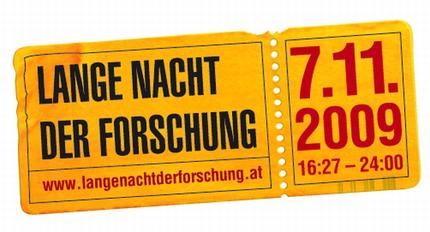Lectures / 07/11/2009 7:00 pm
Open Space?
The long night of scientific and scholarly research at the Kepler Salon
On 7 November the whole country will again focus on research in science and the humanities: in the “Long Night of Research” universities, colleges of further education, all kinds of research institutions and companies committed to research will be throwing open their gates to scientifically minded visitors. Last year more than 200,000 people made use of this opportunity to form their own impression of current trends, cutting-edge technologies and exciting topics of research in the 21st century. This year Kepler Salon will be participating in this science and humanities event, which is the largest of its kind in Austria. In five lectures scheduled between 7 p.m. and midnight representatives of several of Linz’s leading research institutions – Johannes Kepler Universität, the University of Arts and Industrial Design, Anton Bruckner Privatuniversität, Katholisch-Theologische Privatuniversität and the RISC Software GmbH – will be introducing the audience to research projects from the most diverse scientific fields. They will be discussing such topics as the use of biometric methods in criminology, biofeedback and the age old controversy between scientific knowledge and religious belief. They will also demonstrate the immediate practical applicability of technologies with such exotic names as Grid Computing and Fashionable Technology.
7 p.m.
Can biofeedback help body and psyche to understand each other better?
Christian Frauscher
Sigmund Freud described the interpretation of dreams as the “royal road to a knowledge of the unconscious”. Today it is psychophysiology that is advancing along this “royal road”. What processes take place in my body? To what extent does the psyche influence the body? What repercussions does the state of the body have in the psyche? Biofeedback can be instrumental in illuminating the processes that take place in the twilight zone of the unconscious. The use of computer assisted technology that processes visual and/or acoustic biofeedback data enables us to keep tabs on psychophysical processes. It is e.g. possible not only to measure muscle tension, respiratory activity, heart rate and the activity of the sweat glands but to make these parameters visible on the screen, interpret them and modulate them deliberately by appropriate coaching. The possibilities of biofeedback will be demonstrated and research projects of Anton Bruckner Privatuniversität will be summarily introduced.
8 p.m.
Galilei, Darwin, Freud – and God? Knowledge and belief in theological research
Franz Gruber
Since the pioneers of modern science redrew the boundaries between knowledge and belief, these two systems of orientation have been involved in an ongoing controversy often marked by acrimony: “What’s God got to do with science?” versus “What do we stand to lose if we no longer ask eschatological questions?” It is one of the tasks of theological research to redefine the relationship between knowledge and belief. It is obvious for both sides that the concept of God is one that we cannot do without when we ask ultimate questions such as “Why is there ‘something’ rather than ‘nothing’”? The astrophysicist Stephen Hawking gave the following answer on one occasion: “If you like, you can define God to be the answer to that question”. But theology too is called upon to revise its naive discourse on God; after all, “there is no such thing as a God that exists” (D. Bonhoeffer). Knowledge and belief are no clearly demarcated domains today. It is only where they touch that, according to Immanuel Kant, the most relevant questions heave into sight: “What can I know? What ought I to do? For what may I hope? What is a human being?”
9 p.m.
From isolated computers to the computing grid. Computational power straight from the network cloud
Michael Krieger
Way back in the 1960s IT scientists already indulged in visions of the joint use of computer resources, which would be accessible, rather like the telephone network or the electricity grid, across enormous distances. The Internet and the World Wide Web were the first steps in the direction of global networking and the joint use of computers. But it has only been in recent years that massive joint use of computer resources for computational purposes and for data storage has become feasible through the development and construction of so-called computing grids.
It is this joint use of resources made possible by computing grids that enables experiments that were unthinkable only a short time ago. The analysis of particle collisions and of molecules, the simulation of the flow of blood and of weather data, the production of 3-D-models of the Milky Way and even the search for extraterrestrial life are all implemented via grid computing and the hitching-up of computers that are located in companies, universities and private households all over the world.
10 p.m.
Fashionable Technology – The intersection of design, fashion, technology and science
Sabine Seymour
Fashionable technology – this term refers to apparel as an interactive medium. The clothing item is used by its wearer as an interactive medium equipped with sensors, mobile telephony and other data sources.
23:00
Tracking down the criminal. Biometric identification past and present
Peter Becker
Biometric identification systems require a significant amount of technological and organisational input. This is why their application remained confined for a long time to the core area of criminal investigation. In Europe the introduction of fakeproof passports triggered a systematic broadening of the application scope for biometric methods.
In their search for new identification and verification technologies state agencies are no longer left to their own devices. Developing and marketing appropriate technologies have become a lucrative business with a significant growth potential. In 1999 turnover amounted to roughly 100 million dollar, to which the USA contributed 60 %. Today the International Biometric Industry Association (IBIA) reckons the US market alone is worth between 1 and 2.5 billion dollar.
A historical perspective on biometry is exciting for two reasons. First, it yields new insights into how crucial political critique has been and still is. Technocratic fantasies of the feasibility of everything and anything was called into question by civil society actors already in the early 20th century. Second, it demonstrates how government agencies must necessarily adapt to new technologies.
continuative links:
Christian Frauscher:
Franz Gruber:
Michael Krieger:
- www.austriangrid.at
- www.gridipedia.eu
- www.gridcafe.org
- www.worldcommunitygrid.org
- boinc.berkeley.edu
- www.prace-project.eu
- www.risc-software.at
Sabine Seymour:
Bibliography:
Christian Frauscher
- Ingrid Pirker-Binder, Biofeedback in der Praxis,. Band 1: Kinder, Wien 2006.
- Ingrid Pirker-Binder, Biofeedback in der Praxis, Band 2: Erwachsene, Wien 2008.
- Winfried Rief (Hg.) Biofeedback. Grundlagen, Indikationen, Kommunikation, praktisches Vorgehen in der Therapie, 2. Aufl., Stuttgart 2006.
- Rainer Schandry, Biologische Psychologie, 2. Aufl., Weinheim 2006.
- Franz Petermann, Dieter Vaitl (Hg.), Entspannungsverfahren, 4. Aufl., Weinheim 2009.
- Vida C. Baron, Metamedizin. Freiburg 1991.
Franz Gruber
- J. Klose/J. Oehler (Hg.), Gott oder Darwin? Vernünftiges Reden über Schöpfung und Evolution, Heidelberg 2008.
- Hans Küng, Der Anfang aller Dinge. Naturwissenschaft und Religion, München 2005.
- Jürgen Habermas, Glauben und Wissen, Frankfurt/M. 2001.
Sabine Seymour
- Sabine Seymour, Fashionable Technology. The Intersection of Design, Fashion, Science and Technology, Wien/NewYork 2008.
Details
Lecturer: Christian Frauscher, Peter Becker, Franz Gruber, Michael Krieger, Sabine Seymour
Host: Christine Haiden, Silvia Keller, Iris Mayr, Elfie Schulz, Constanze Wimmer









